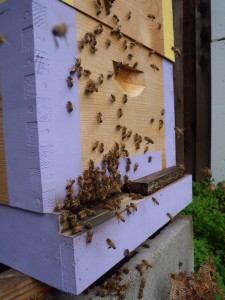Last spring I split two beehives. The results were mediocre. In one case, the mother colony failed to raise a new queen, while the daughter colony raised a veritable egg-laying machine. In the other case, the mother colony raised a viable queen, while the daughter colony ultimately became drone-laying. In both cases, I had to recombine the hives, so ended up with the same number that I started with and a lot of wasted time.
I’m not sure what went wrong with my hive splits, though I do wonder if several horribly timed weeks of vicious wind may have interfered with successful mating flights for the virgin queens.
Though I dutifully followed my hive splitting instructions, I am also more than ready to assume responsibility for the failed splits. Both hives had closed queen cells at the time I split them, and one had swarmed earlier that day. My timing for splitting the hives may not have been good, and my technique was quite possibly flawed.
The resolution…
This is all longwinded background to get to the second of this year’s garden resolutions. This spring, I will increase my number of hive divisions and hone my colony splitting skills.
Aside from a nifty beekeeping trick to acquire, I think mastering the art of beehive division is an essential part of becoming a self-sufficient beekeeper, as well as strengthening the stock in our apiary.
There are many, many reasons we have sworn off commercial honey bee packages (more on this another time). Swarm capturing, swarm luring, and hive division are three much better alternatives for populating the bee yard. But as much as I love the thrill of climbing the extension ladder to collect our top-bar hive’s fifth swarm of the season (no really, I do!), dividing our best colonies when they are ready to swarm is more efficient and likely to give us more bees at the end of the day. It’s also a safer bet in terms of neighbor relations; there’s nothing like a cloud of bees eclipsing the sun to get people nervous.
Walk away splits, my hive division method of choice, involves much more than just throwing some bees, eggs, honey, and pollen into a new box and waiting for the nurse bees to raise a queen. It’s also about reading the mother colony, watching the ratio of open to closed brood, understanding when the bees are ready to begin swarming preparations, organizing the frames in the new split so that the bees have easy access to the resources they need to raise a strong queen, and much more.
In the moment, sweating in my bee suit and squinting at frames trying to spot eggs (while also trying not to chill the brood), I’m not always as centered or intentional as I’d like to be. I forget things I’ve read that seemed important. I second-guess myself. I fret.
Does practice make perfect? I doubt it, but I’ll see this spring. And I’ll try hard to document and share what I learn.
If all this seemed like impossibly complicated bee lingo, stay tuned. I will keep adding to our beekeeping glossary, and I’ll try to demystify the colony division process on the blog as I practice it myself.


